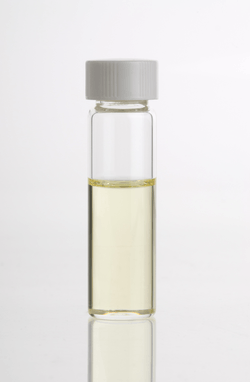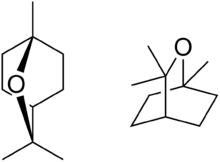Lavender oil
Lavender oil is an essential oil obtained by distillation from the flower spikes of certain species of lavender. Two forms are distinguished, lavender flower oil, a colorless oil, insoluble in water, having a density of 0.885 g/mL; and lavender spike oil, a distillate from the herb Lavandula latifolia, having density 0.905 g/mL. Like all essential oils, it is not a pure compound; it is a complex mixture of phytochemicals, including linalool and linalyl acetate. As of 2011, the biggest lavender oil producer in the world is Bulgaria.[1]

Production
Pure lavender essential oil is produced through steam distillation. This generates a greater amount of oil compared to other methods due to reduction of polar compound loss.[2] Harvest of lavender blooms are typically around June. Lavender flowers are compacted into a still. Fewer air pockets in the still result in greater oil yield. A boiler is then used to steam the bottom of the lavender flower filled still at a very low pressure. The lavender flower pockets containing oil are broken from this heating process and a pipe of cold water is run through the center of the still. The hot lavender oil vapor condenses on the cold pipe with the cold water and is collected into a holding tank where it is allowed to settle. Due to polarity and densities of the water and oil, these two will separate in the holding tank whereupon the water is piped out, leaving just lavender essential oil.[3]
Uses
Lavender oil has long been used as a perfume, for aromatherapy, and for skin applications.[4][5]:184–186 Lavender oil is used in massage therapy as a way of inducing relaxation through direct skin contact.[4][6]
Oil of spike lavender was used as a solvent in oil painting, mainly before the use of distilled turpentine became common.[7]
Research directions
Lavender oil has been researched for possible application in treating anxiety: there is weak evidence that lavender oil supplements may help with subthreshold anxiety [8]
Adverse effects
In rare cases, lavender oil in soaps, shampoos, and other skin applied medications may cause prepubertal gynecomastia (breast development in young boys).[9] Other potential adverse effects include a sedative effect and contact dermatitis as an allergic reaction, possibly resulting from major lavender oil constituents, camphor, terpinen-4-ol, linalool and linalyl acetate.[10][4]
In Australia lavender oil is one of the many essential oils that have been increasingly causing cases of poisoning, mostly of children. In the period 2014-2018 there were 271 reported cases in New South Wales, accounting for 6.1% of essential oil poisoning incidents.[11]
Composition
The exact composition of lavender essential oil varies from species to species but consists primarily of monoterpeneoids and sesquiterpeneoids. Of these linalool and linalyl acetate dominate, with moderate levels of lavandulyl acetate, terpinen-4-ol and lavandulol. 1,8-cineole and camphor are also present in low to moderate qualities. In all lavender oil typically contains many more than 100 compounds, although a great many of these are present at very low concentrations.[12]
The composition of lavender essential oil as obtained by chromatography:
| Family | Composition | Lavande officinale Lavandula angustifolia |
Lavande aspic Lavandula latifolia |
|---|---|---|---|
| Terpenes / Monoterpenols |
Linalool | 28.92 % | 49.47 % |
| α-Terpineol | 0.90% | 1.08% | |
| γ-Terpineol | 0.09% | ||
| Borneol | 1.43% | ||
| Isoborneol | 0.82% | ||
| Terpinen-4-ol | 4.32% | ||
| Nerol | 0.20% | ||
| Lavandulol | 0.78% | ||
| Terpenes / Terpene esters |
 | 32.98 % | |
| Geranyl acetate | 0.60% | ||
| Neryl acetate | 0.32% | ||
| Octene-3-yl acetate | 0.65% | ||
| Lavandulyl acetate | 4.52% | ||
| Terpenes / Monoterpenes |
Myrcene | 0.46% | 0.41% |
| α-Pinene | 0.54% | ||
| β-Pinene | 0.33% | ||
| Camphene | 0.30% | ||
| (E)-β-Ocimene | 3.09% | ||
| (Z)-β-Ocimene | 4.44% | ||
| β-Phellandrene | 0.12% | ||
| Terpenes / Terpenoid oxides |
 Eucalyptol (1,8-cineol) | 25.91 % | |
| Terpenes / Sesquiterpenes |
β-Caryophyllene | 4.62% | 2.10% |
| β-Farnesene | 2.73% | ||
| Germacrene | 0.27% | ||
| α-Humulene | 0.28% | ||
| Ketones |  Camphor |
0.85% | 13.00 % |
| 3-Octanone | 0.72% | ||
 Cryptone | 0.35% |
References
- Bulgarian lavender producers worried about demand drop, China Post, 14 July 2011
- Masango P (2005-06-01). "Cleaner production of essential oils by steam distillation". Journal of Cleaner Production. 13 (8): 833–839. doi:10.1016/j.jclepro.2004.02.039. ISSN 0959-6526.
- Chanamai R, Horn G, McClements DJ (March 2002). "Influence of oil polarity on droplet growth in oil-in-water emulsions stabilized by a weakly adsorbing biopolymer or a nonionic surfactant". Journal of Colloid and Interface Science. 247 (1): 167–76. Bibcode:2002JCIS..247..167C. doi:10.1006/jcis.2001.8110. PMID 16290453.
- Sarkic A, Stappen I (12 January 2018). "Essential oils and their single compounds in cosmetics: A critical review". Cosmetics. 5 (1): 11. doi:10.3390/cosmetics5010011. ISSN 2079-9284.
- Groom N (1997). The New Perfume Handbook (2nd ed.). Blackie Academic & Professional. ISBN 978-0-7514-0403-6.
- Fismer KL, Pilkington K (2012). "Lavender and sleep: A systematic review of the evidence". European Journal of Integrative Medicine. 4 (4): e436–e447. doi:10.1016/j.eujim.2012.08.001.
- Ward GW, ed. (2008). The Grove encyclopedia of materials and techniques in art. Oxford University Press. pp. 605–606. ISBN 978-0-19-531391-8.
- Möller HJ, Volz HP, Dienel A, Schläfke S, Kasper S (March 2019). "Efficacy of Silexan in subthreshold anxiety: meta-analysis of randomised, placebo-controlled trials". European Archives of Psychiatry and Clinical Neuroscience. 269 (2): 183–193. doi:10.1007/s00406-017-0852-4. PMC 6726711. PMID 29150713.
- Henley DV, Lipson N, Korach KS, Bloch CA (February 2007). "Prepubertal gynecomastia linked to lavender and tea tree oils". The New England Journal of Medicine. 356 (5): 479–85. doi:10.1056/NEJMoa064725. PMID 17267908.
- Elshafie HS, Camele I (5 November 2017). "An Overview of the Biological Effects of Some Mediterranean Essential Oils on Human Health". BioMed Research International. 2017: 9268468. doi:10.1155/2017/9268468. PMC 5694587. PMID 29230418.
- Lee KA, Harnett JE, Cairns R (November 2019). "Essential oil exposures in Australia: analysis of cases reported to the NSW Poisons Information Centre". The Medical Journal of Australia. doi:10.5694/mja2.50403. PMID 31709543. Lay summary.
- Shellie R, Mondello L, Marriott P, Dugo G (September 2002). "Characterisation of lavender essential oils by using gas chromatography-mass spectrometry with correlation of linear retention indices and comparison with comprehensive two-dimensional gas chromatography". Journal of Chromatography. A. 970 (1–2): 225–34. doi:10.1016/S0021-9673(02)00653-2. PMID 12350096.